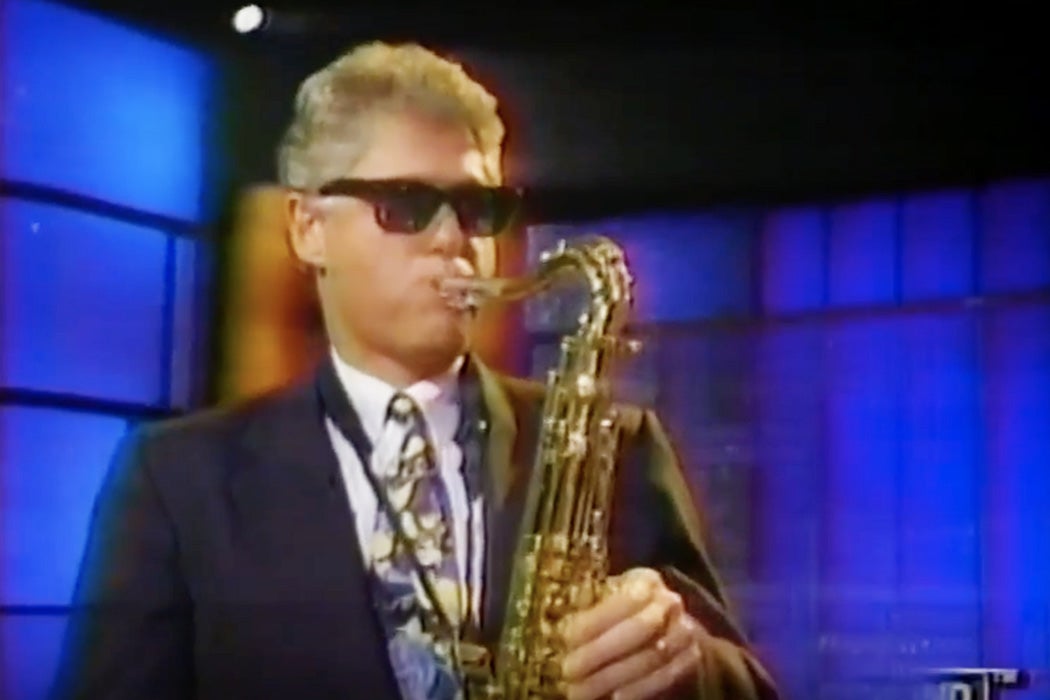John F. Kennedy may have been the first major political candidate to go on late-night television when he visited Tonight Starring Jack Paar in 1960, but one of the most significant appearances, the catalyst for so many in the years since, was Bill Clinton’s appearance on The Arsenio Hall Show in 1992, when he infamously played the saxophone. A captive audience of millions, a relaxed atmosphere, a chance to seem relatable—why wouldn’t a political candidate do the talk show rounds?
Indeed, critics suggest that these appearances create a focus on image rather than policy, but research into the 2004 appearance of Democratic presidential candidate John Kerry on Letterman demonstrates that young people who watched the show became knowledgeable of key issues in his campaign. Oberlin politics professor Michael Parkin writes that after watching the interview, viewers emphasized policy positions about which Kerry had spoken in regard to security and the economy. This was in contrast to those getting information from an explicitly political news show such CBS News’s Face the Nation; Parkin’s experiments show that it was “almost like having no exposure to it at all.”
As political scientist Matthew A. Baum notes, serving politics via late-night captures the attention of otherwise politically disinterested viewers. While members of the viewing audience may not be the most politically engaged, they vote in significant enough numbers for campaign managers to consider it worthwhile. For those trying to poach voters from the opposition, it may be even more worthwhile. Those normally disengaged viewers are more likely “to find the opposition party candidate likeable, as well as to cross party lines and vote for [them]…”
The absence of negativity, at least while the candidate is physically present, turns out to be a boon. This is why late-night can be a good shout even for divisive figures. During the 2016 presidential cycle, then-candidate Donald Trump appeared on Fallon, where the host famously ruffled Trump’s hair. After the latter was elected, that moment was condemned by some as having inadvertently undermined the danger of Trump.
Weekly Newsletter
In the past, hosts like Johnny Carson and Jay Leno avoided taking partisan stances so they wouldn’t alienate half their viewers. Letterman and his successor, Conan O’Brien, did the same for the most part. In more recent years, journalists have discussed what is perceived as an increasing politicization and partisanship of late-night, tracing this phenomenon back to Jon Stewart taking over The Daily Show. Stewart “injected point of view,” writes Bill Carter for CNN. “Late night has not looked back since.”
During the 2004 presidential primaries, most Democratic candidates appeared on shows like: The Jay Leno Show, Letterman, and The Daily Show. According to Variety, politicians made more than 100 appearances on late-night during the 2008 presidential cycle. Obama became the first sitting president to appear on late-night, and Biden has followed his example, appearing on Jimmy Kimmel Live! for his presidential late-night debut. There’s been a trickle-down of sorts with not just presidential candidates but everyone from senators to congresspeople, Joe Kennedy III to Alexandria Ocasio-Cortez, doing the late-night circuit. In an era where a ninety-second clip can gain millions of views beyond the night it airs, late-night looks like it will continue to be an arena into which some politicians will feel the need to enter.
Support JSTOR Daily! Join our new membership program on Patreon today.







